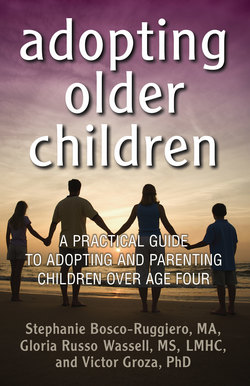Читать книгу Adopting Older Children - Stephanie Bosco-Ruggiero - Страница 17
На сайте Литреса книга снята с продажи.
ОглавлениеCHAPTER 6
Welcoming Your Child Home
For a child adopted from the US foster care system by someone who is not a relative or foster parent, the process of coming home is gradual. First you meet with your prospective child at the agency, then the agency arranges for the child to visit with you. The initial outings or visits will be short, while later visits will be longer. As the relationship grows, the child may come to visit you for a few days and then gradually increase to a week or two. The child’s school schedule may affect the timing of these visits and you may need to discuss the timing of the visits with the child’s foster parents.
During this visitation period, the child’s caseworker as well as your caseworker will check in with you and the child about how you are getting along. If all parties are feeling positive about the visits and the placement, the agency will make a pre-adoptive placement of the child in your home. At this point he leaves his foster or group home to come to live with you until the adoption is legally finalized. During this time the agency will continue to make home visits and you may be asked to complete additional paperwork or training.
Children adopted by their foster parents or relative caregivers or guardians are already home, so the process of being legally adopted may not be as pronounced a transition as it is for other foster children. Nonetheless, they too have to adjust to the idea of having permanent parents. This could be scary for these children as well, because they will not want to do anything to disrupt the adoption. Some children may be confused about what being adopted means and how this will change their relationships with their caregivers. According to research by Tiffany Conway and Rutledge Q. Hutson, children adopted by relative caregivers may have fewer adjustment problems, because they can maintain closer contact with biological parents and other family members.1
For children adopted from another country, the coming home process is more abrupt but more countries are implementing protocols to make the transition easier for older children and teens. At first you may be permitted to visit with the child at the orphanage and take walks with her around the grounds. After that, you may be permitted to make longer visits and eventually have the child stay with you overnight.
Children adopted internationally may have more difficulty than children adopted domestically when adjusting to their new homes. Not only are they adjusting to living in a family, which they may never have done before, but they must adjust to a new culture, language and country too!
PREVENTING ADOPTION DISRUPTION
Adoption disruption occurs when an adoption never reaches legal finalization. Ten to fifteen percent of American domestic adoptions are disrupted while intercountry adoptions are rarely disrupted, because they are generally finalized before the child leaves the country.2 An adoption can be disrupted because either the child or parent decides the placement is not working. The age at which children can consent to an adoptive placement varies from state to state.3
Adoptions are less likely to disrupt when:
• Parents are well prepared for older child adoption through training and education
• Adoptive parents have complete and accurate information about the child they are adopting
• The adoptive child and parents are well-matched
• Quality post-placement support is available
